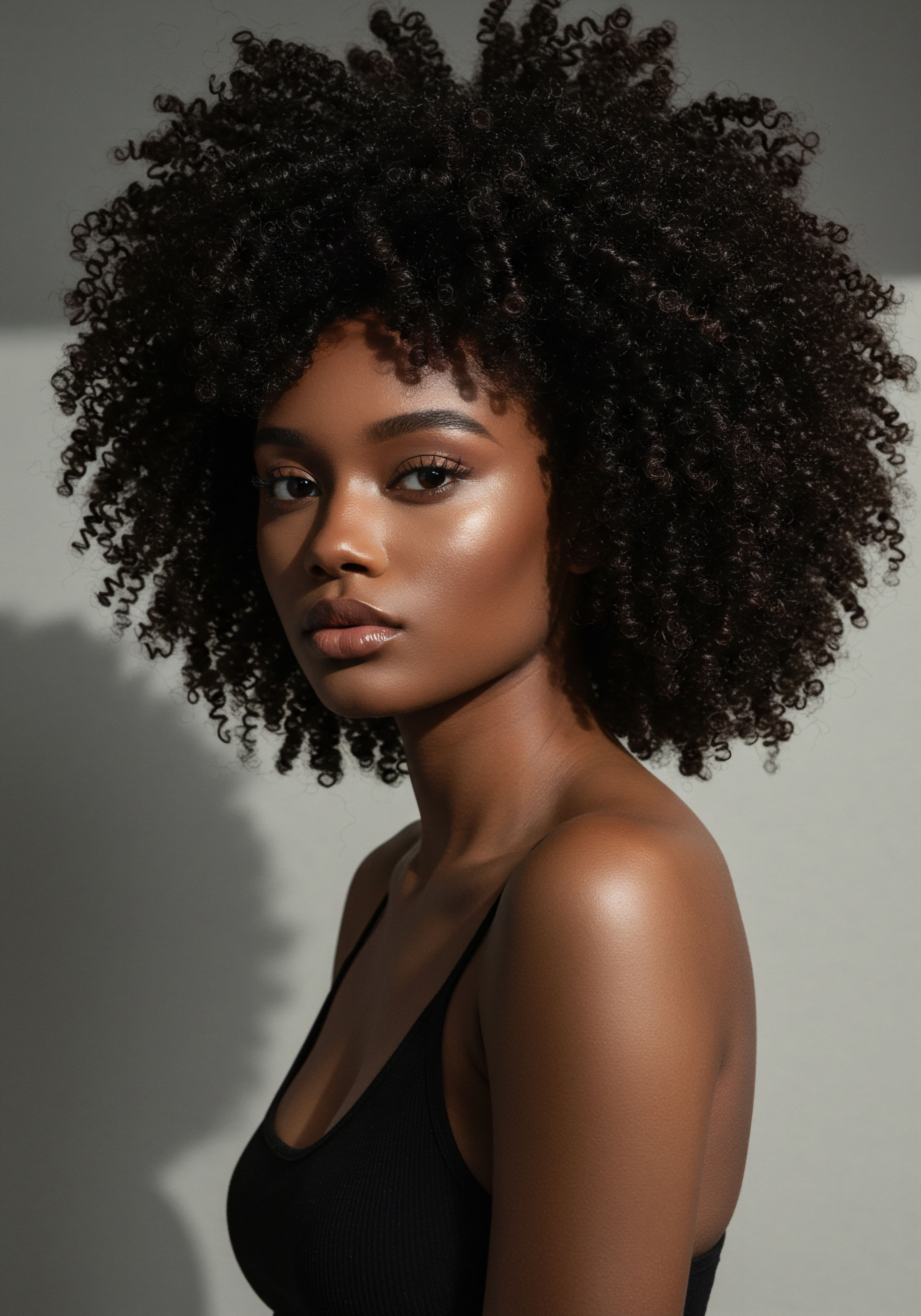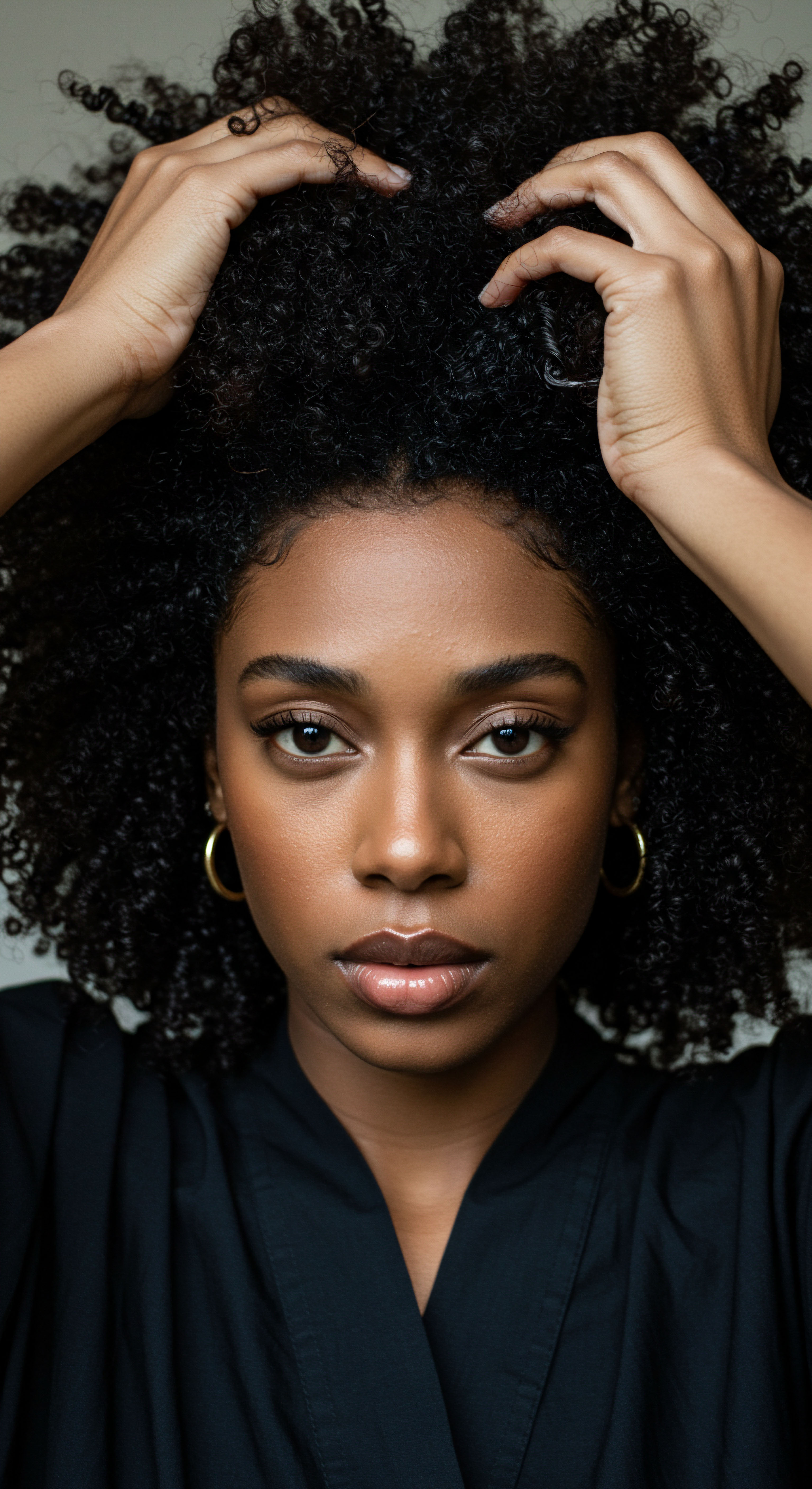
Roots
Within the quiet rhythms of our lives, often unseen, a profound interplay unfolds between our nightly slumber and the vitality of our hair. We speak of beauty sleep, yet rarely pause to consider the deep, cellular symphony that occurs as we rest. This exploration begins at the very source, examining the foundational connections between our sleep cycles and the growth of our strands, inviting a deeper connection to the science that governs our crowning glory.

The Architecture of a Strand
Each individual hair strand, seemingly simple, represents a complex biological structure. It emerges from a specialized organ within the skin, the Hair Follicle. These tiny powerhouses are not merely static conduits for hair; they are dynamic mini-organs, each with its own rhythm and purpose. Understanding the hair follicle’s fundamental workings provides a lens through which to view its responsiveness to the body’s internal clock.
The hair follicle itself comprises several distinct parts, each playing a role in the growth process. At its base lies the Dermal Papilla, a cluster of specialized cells that receive nourishment from the bloodstream. Surrounding this is the hair matrix, where cells rapidly divide and differentiate to form the hair shaft. This intricate cellular machinery requires a steady supply of energy and specific signals to function optimally.
The hair follicle, a dynamic mini-organ, possesses an intrinsic rhythm influencing strand vitality.

Hair’s Unseen Cadence
Hair growth follows a cyclical pattern, a biological dance that unfolds over years. This cycle has three main acts ❉ anagen, catagen, and telogen. Each phase holds distinct cellular activities, dictating whether a hair is actively growing, transitioning, or resting before shedding.
- Anagen ❉ This is the active growth phase, lasting anywhere from two to seven years. During this period, cells in the hair matrix divide rapidly, pushing the hair shaft upward and outward. The length of this phase largely determines the maximum length a hair can achieve.
- Catagen ❉ A brief transitional phase, typically lasting a few weeks. Growth ceases, and the hair follicle shrinks, detaching from the dermal papilla. It prepares for the resting stage.
- Telogen ❉ The resting phase, lasting a few months. The hair remains in the follicle, but no active growth occurs. At the end of this phase, the old hair sheds, making way for a new anagen hair to begin its cycle.
These cycles are not isolated events; they are finely tuned by internal biological clocks and external cues. The body’s circadian rhythm, a roughly 24-hour cycle that regulates sleep-wake patterns, hormone release, and other bodily functions, stands as a primary conductor of this biological orchestra. Just as our energy levels ebb and flow with the sun’s rise and fall, so too do the cellular activities within our hair follicles respond to these inherent rhythms.
During the deep stages of sleep, particularly the non-REM phases, the body dedicates itself to repair and regeneration. This is a time of heightened cellular turnover and tissue repair. Crucially, during these restorative hours, the body releases a cascade of hormones, including those directly linked to growth and regeneration. The hair follicle, a site of continuous cellular division, stands to benefit immensely from these nocturnal processes.
Consider the delicate balance of these internal workings. Any disruption to the body’s natural sleep cadence can send ripples through these finely tuned systems, potentially altering the harmonious progression of hair growth. A sustained lack of restorative sleep can, over time, lead to a compromised environment for hair follicles, influencing their ability to perform their vital functions with vigor.

Ritual
Moving from the unseen mechanics to the lived experience, we arrive at the practices that shape our daily and nightly interactions with our hair. The notion of “ritual” here extends beyond mere routine; it encompasses the conscious acts of care, the gentle preparations, and the protective measures we undertake as dusk descends. Understanding how our sleep habits, and the deliberate actions surrounding them, can influence the very fabric of our hair’s well-being opens a path to more informed and intentional care.

Why Nighttime Care Holds Weight
The hours spent in slumber are not dormant for our hair. Quite the contrary, this period presents a unique opportunity for restoration and protection. As we drift into unconsciousness, our bodies are hard at work, performing reparative tasks that are less efficient during waking hours. For textured hair, which often requires extra care to maintain its moisture and structural integrity, these nighttime hours become especially important.
Think of the scalp as a garden bed, and the hair strands as the plants. Just as a garden needs careful tending, especially during periods of rest and recovery, so too does our scalp and hair. Neglecting nighttime care can expose hair to unnecessary friction, moisture loss, and physical stress, undoing the efforts of daytime routines. Conversely, a thoughtful nighttime regimen can significantly contribute to hair health and resilience over time.
Nighttime provides a unique opportunity for hair restoration and protection, especially for textured strands.

Crafting a Sleep Sanctuary for Strands
The quality of our sleep environment directly impacts our hair. Simple adjustments can make a world of difference. Consider the materials your hair comes into contact with during the night.
Cotton pillowcases, while comfortable, can absorb moisture from hair, leading to dryness and friction. This friction can cause tangling, breakage, and the disruption of the hair’s outer cuticle layer, resulting in frizz and dullness.
A preferred alternative for textured hair is a Satin or Silk Pillowcase. These materials create less friction, allowing hair to glide smoothly across the surface. This reduces tangles, minimizes breakage, and helps preserve the hair’s natural moisture. The smooth surface also prevents the lifting of the cuticle, contributing to a softer, shinier appearance upon waking.
Beyond pillowcases, protective styling during sleep offers another layer of defense. Loose braids, twists, or a simple pineapple bun (gathering hair at the top of the head) can prevent hair from getting tangled or crushed during restless sleep. These styles minimize tension on the scalp and protect the delicate ends of the hair, which are often the most vulnerable to damage.
The choice of head covering also plays a significant role. A satin or silk bonnet, scarf, or cap provides a secure, friction-free environment for hair throughout the night. These coverings protect hair from the drying effects of ambient air and prevent snagging on bedding. For individuals with textured hair, this becomes an essential tool in maintaining moisture, preserving style, and reducing the need for excessive manipulation in the morning.
- Protect with Satin or Silk ❉ Opt for pillowcases or head coverings made from satin or silk to reduce friction and retain moisture.
- Style for Safety ❉ Arrange hair in loose braids, twists, or a high bun to prevent tangles and breakage during sleep.
- Maintain Moisture ❉ Apply a light leave-in conditioner or hair oil before bed to replenish hydration lost throughout the day.
A table outlining common nighttime hair protection options:
| Protection Method Satin/Silk Pillowcase |
| Primary Benefit Reduces friction, retains moisture |
| Best For All hair types, especially delicate or dry |
| Protection Method Satin/Silk Bonnet |
| Primary Benefit Full coverage, moisture retention, style preservation |
| Best For Textured hair, protective styles |
| Protection Method Loose Braids/Twists |
| Primary Benefit Prevents tangles, reduces breakage |
| Best For Longer hair, textured hair |
| Protection Method Pineapple Bun |
| Primary Benefit Preserves curl pattern, reduces flattening |
| Best For Curly and coily hair |
| Protection Method Selecting the right method safeguards strands against nocturnal wear. |

The Body’s Internal Clock and Hair’s Rhythm
Our bodies operate on a circadian rhythm, a natural, internal process that regulates the sleep-wake cycle and repeats roughly every 24 hours. This rhythm influences various physiological processes, including hormone secretion, cell regeneration, and even blood flow. Hair follicles, remarkably, also exhibit their own circadian clock, with certain gene activities peaking at specific times.
When sleep patterns are erratic or insufficient, this internal timing can be thrown off balance. The consequence for hair can be a disruption in its natural growth cycle, potentially shortening the active anagen phase and prematurely signaling the hair to enter the resting or shedding phases. This subtle, yet consistent, interference can contribute to reduced hair density and slower growth over time. Cultivating consistent sleep habits thus becomes a gentle yet powerful act of care for the hair’s inherent rhythm.

Relay
Beyond the fundamental mechanics and daily practices, a deeper inquiry into the influence of sleep cycles on hair growth reveals a complex interplay of biological signals, hormonal fluctuations, and even systemic responses to stress. This section endeavors to illuminate the less apparent connections, drawing upon scientific observations and the subtle wisdom of the body’s interconnected systems, providing a more comprehensive view of how our sleep truly resonates within the hair follicle.

The Hormonal Orchestra of the Night
Sleep is far from a passive state; it is a period of intense hormonal activity that directly impacts bodily repair and growth, including that of hair. Two key players in this nocturnal symphony are Melatonin and Growth Hormone. Melatonin, often called the “sleep hormone,” primarily regulates our circadian rhythm.
However, its role extends beyond inducing slumber. Research indicates that melatonin directly influences hair follicle cycling, potentially prolonging the active growth phase and exhibiting antioxidant properties that protect follicles from oxidative stress.
Growth hormone (GH), primarily secreted during deep non-REM sleep, is another significant contributor. This hormone is vital for cell reproduction and regeneration throughout the body, including the rapidly dividing cells within the hair matrix. Insufficient deep sleep can lead to reduced GH secretion, potentially impeding the robust cellular activity necessary for healthy hair growth.
Conversely, disruptions in sleep can lead to an elevation of stress hormones, particularly Cortisol. While cortisol is essential for regulating our sleep-wake cycle and stress response, chronically high levels, often seen with prolonged sleep deprivation, can be detrimental to hair health. Elevated cortisol can prematurely push hair follicles from the active growth phase into the resting (telogen) phase, leading to increased shedding, a condition known as Telogen Effluvium.

How Does Chronic Sleep Disruption Alter Hair Follicle Signaling?
The hair follicle is remarkably sensitive to its microenvironment, including changes in hormonal balance and inflammatory signals. Chronic sleep disruption can create a systemic environment that is less than ideal for hair growth. Beyond direct hormonal shifts, poor sleep can lead to increased systemic inflammation and oxidative stress, both of which can negatively affect hair follicle health and function. These internal stressors can impair the hair follicle’s ability to regenerate and sustain healthy growth.
A notable observation comes from the period of the COVID-19 pandemic. Studies have suggested an increase in the prevalence of sleep disturbances during this time, often accompanied by heightened stress and anxiety. These factors were then linked to a rise in conditions like telogen effluvium.
For instance, a commentary published in the Journal of Cosmetic Dermatology in 2021 discussed how the COVID-19 pandemic, by leading to increased sleep disturbances, consequently resulted in higher states of stress and anxiety, which are recognized triggers for telogen effluvium. This highlights a real-world scenario where widespread sleep disruption, even if indirectly through stress, can manifest as visible changes in hair density and health.

The Circadian Clock Within the Hair Follicle Itself
Perhaps one of the most fascinating aspects of this relationship is the discovery that hair follicles possess their own internal “clock genes.” These genes are part of the peripheral circadian system, meaning they operate with a rhythm independent of, yet synchronized with, the brain’s central clock. These follicular clock genes influence various processes within the hair follicle, including the timing of growth, differentiation, and even pigmentation.
When the body’s central circadian rhythm is significantly disturbed, as seen in chronic shift workers or individuals with severe sleep disorders, this disruption can extend to the peripheral clocks within the hair follicles. Such desynchronization can lead to impaired stem cell activity within the follicle, reducing its regenerative capacity over time. A 2019 study in Cell Reports, for example, linked circadian rhythm disruptions to decreased stem cell activity in hair follicles, showing that chronic disruption can reduce the regenerative capacity of these cells. This points to a deeper, more fundamental connection where the very timing mechanisms within the hair itself are affected by our sleep patterns.
The bidirectional regulatory effects of melatonin on hair follicle stem cells are also a subject of ongoing research. While low doses of melatonin may support the survival rate of hair follicle stem cells, higher doses can have an opposing effect. This complexity underscores the delicate balance required for optimal hair growth and the potential for even beneficial substances to have varied impacts depending on their concentration and context.
This deeper understanding of sleep’s systemic and localized effects on hair growth underscores the idea that hair vitality is not an isolated concern. It is inextricably linked to our overall physiological balance, with our nightly rest serving as a cornerstone of its well-being. Recognizing these intricate connections empowers us to approach hair care not merely as an external application of products, but as a holistic commitment to the body’s internal rhythms.

Reflection
As we conclude this exploration, a quiet truth settles ❉ the quiet hours of our sleep are not merely a pause from the day’s demands, but a period of profound biological renewal, intimately tied to the life of our hair. The delicate dance of hormones, the intrinsic rhythm of follicular cells, and the systemic responses to rest or its absence all paint a picture of interconnectedness. Our textured strands, vibrant and resilient, echo the well-being of our entire being. May this understanding guide us toward a more mindful approach to our nightly repose, recognizing it as a gentle, yet powerful, act of care for the hair that crowns us.

References
- Rusanova, I. & Jagannath, A. (2023). Melatonin’s Role in Hair Follicle Growth and Development ❉ A Cashmere Goat Perspective. Animals, 13(2), 295.
- HHC Clinics. (n.d.). Sleep and Hair Growth – What’s the Connection? Retrieved from HHC Clinics website.
- Centre Clauderer. (n.d.). Hair and sleep ❉ the importance of the night for hair health. Retrieved from Centre Clauderer website.
- Hair Doctors. (2025, April 2). Can Lack of Sleep Make You Lose Hair? Uncovering the Connection. Retrieved from Hair Doctors website.
- HairFree & HairGrow. (2023, October 27). Sleep and Hair Loss. Relationship Explained. Retrieved from HairFree & HairGrow website.
- Ghergherehchi, M. & Dabbagh, F. (2021). Growth Hormone and the Human Hair Follicle. Dermato-Endocrinology, 13(1), 1990435.
- RHRLI. (n.d.). Is Sleep Important for Hair Growth? Retrieved from RHRLI website.
- Oriental Hair Solutions Blog. (2020, May 8). Sleep and your hair. Retrieved from Oriental Hair Solutions Blog website.
- Longevita Hair Transplant. (2024, December 19). Does HGH Help Hair Growth? Retrieved from Longevita Hair Transplant website.
- Fisher, J. & Draelos, Z. D. (2023). Melatonin and the Human Hair Follicle. Journal of Drugs in Dermatology, 22(2), 174-177.
- trichology. (2024, July 29). Sleep And Hair Growth ❉ Enhance Your Hair Health Through Better Sleep. Retrieved from trichology website.
- Cleveland Clinic. (n.d.). Cortisol ❉ What It Is, Function, Symptoms & Levels. Retrieved from Cleveland Clinic website.
- DiStefano Hair Restoration Center. (2025, March 7). Does Sleep Affect Hair Health? Retrieved from DiStefano Hair Restoration Center website.
- Xu, Y. Yu, X. & Liu, B. (2025). Melatonin-Mediated Circadian Rhythm Signaling Exhibits Bidirectional Regulatory Effects on the State of Hair Follicle Stem Cells. Biomolecules, 15(2), 226.
- Kono, T. & Aiba, S. (2023). Hair Follicles as a Critical Model for Monitoring the Circadian Clock. International Journal of Molecular Sciences, 24(3), 2601.
- Xu, Y. Yu, X. & Liu, B. (2025). Melatonin-Mediated Circadian Rhythm Signaling Exhibits Bidirectional Regulatory Effects on the State of Hair Follicle Stem Cells. PubMed. PMID ❉ 40001528; PMCID ❉ PMC11852975.
- Huang, Y. et al. (2023). The mutual impacts of stem cells and sleep ❉ opportunities for improved stem cell therapy. Cell & Bioscience, 13(1), 73.
- HairMD Pune. (2023, August 9). Lack of Sleep Can Cause Hair Loss? Retrieved from HairMD Pune website.
- The Hairy Pill. (n.d.). Does Lack of Sleep Cause Hair Loss? Retrieved from The Hairy Pill website.
- Good Health by Hims. (2024, November 24). Does Lack of Sleep Cause Hair Loss? Retrieved from Good Health by Hims website.
- Rossi, A. et al. (2021). The role of sleep in telogen effluvium and trichodynia ❉ A commentary in the context of the current pandemic. Journal of Cosmetic Dermatology, 20(4), 1088-1090.
- Rossi, A. et al. (2024, December 9). The role of sleep in telogen effluvium and trichodynia ❉ A commentary in the context of the current pandemic. Request PDF. Retrieved from ResearchGate.